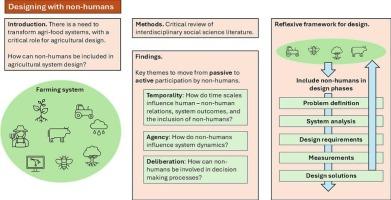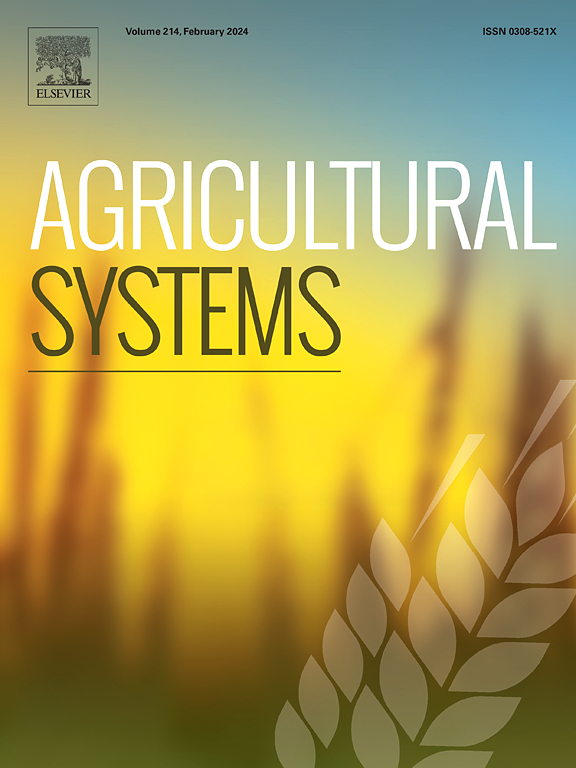农业系统转型的非人类设计:跨学科回顾与反思框架
IF 6.1
1区 农林科学
Q1 AGRICULTURE, MULTIDISCIPLINARY
引用次数: 0
摘要
背景:随着人们对农业对气候和生态危机的影响日益关注,最近对可持续粮食系统的定义已经超越了生产力范畴,强调相互关联的生态和社会层面。为了应对这一挑战,农业系统设计学者已经不再仅仅关注提高生产力、供应和盈利能力,而是将动物福利和生态健康等目标纳入其中。然而,这种选择往往无法超越以人类为中心的需求和价值观。为了使设计具有变革性,解决谁可以参与设计以及参与者如何相互联系是至关重要的。值得注意的是,非人类作为农业系统的基础,在很大程度上被忽视了参与设计过程的参与者。本文的目的是建立一个框架,通过识别和反思权衡,并提供方法论工具,为农业系统的公正和可持续转型做出贡献,帮助农业设计学者有意义地将非人类需求整合到农业设计过程中。方法对非人类参与农业系统设计研究的最新进展进行了批判性回顾。接下来是一篇叙述性的回顾,参考了一些关键社会科学的方法,如过渡研究、演员网络理论、动物研究、女权主义后人文主义、后殖民主义和土著学术,以增强我们对非人类参与的理解。这一分析为反思提供了一个综合框架。结果与结论本综述指出了三个主题,以更好地参与非人类设计,特别是关于(1)机构的作用;(2)暂时性;(3)非人类审议。基于这些主题,提出了将非人类纳入五个设计阶段的实际步骤:问题定义;系统分析;设计要求;测量;选择设计方案。通过开启农业系统设计与不同研究机构之间关于非人类纳入的对话,本文旨在通过培养新的思维方式和将非人类作为这些过程中的主动而非被动参与者,支持农业系统设计师进行反思,做出明智的、对环境敏感的决策。从而提高农业系统研究和设计超越人类中心观点的变革潜力。本文章由计算机程序翻译,如有差异,请以英文原文为准。

Designing with non-humans for agricultural systems transformation: An interdisciplinary review and framework for reflection
CONTEXT
In response to growing concern over agriculture's contribution to climate and ecological crises, recent definitions of sustainable food systems have expanded beyond productivity to emphasize interconnected ecological and social dimensions. Responding to this challenge, agricultural system design scholars have moved beyond a focus on merely increasing productivity, supply, and profitability, to include goals such as animal welfare and ecological health. However, this selection often fails to move beyond anthropocentric needs and values. For design to be transformative, addressing who can participate in design and how participating actors relate to each other is critical. Notably, non-humans, which are foundational to agricultural systems, are largely overlooked as actors to be involved in design processes.
OBJECTIVE
The aim of the article is to develop a framework to assist agricultural design scholars in meaningfully integrating non-human needs in agricultural design processes by identifying and reflecting upon trade-offs and providing methodological tools with the goal of contributing to just and sustainable transformations of agricultural systems.
METHODS
A critical review of the state-of-the-art of non-human participation in agricultural systems design research was done. This was followed by a narrative review, consulting several approaches from critical social sciences, such as transition studies, Actor Network Theory, animal studies, feminist posthumanism, postcolonialism and indigenous scholarship to enhance our understanding of participation by non-humans. This analysis informed a synthesized framework for reflection.
RESULTS AND CONCLUSIONS
The review points at three themes for better engagement of non-humans in design, notably regarding the role of (1) agency; (2) temporality; and (3) deliberation of non-humans. Based on these themes, practical steps forward are proposed to include non-humans in five design phases: problem definition; system analysis; design requirements; measurements; and selecting design solutions.
SIGNIFICANCE
By opening a dialogue between agricultural systems design and different bodies of research on inclusion of non-humans, this article aims to support agricultural systems designers in their reflection, making informed, context-sensitive decisions by fostering new ways of thinking and relating to non-humans as active rather than passive actors in these processes, thereby enhancing the transformative potential of agricultural systems research and design beyond anthropocentric perspectives.
求助全文
通过发布文献求助,成功后即可免费获取论文全文。
去求助
来源期刊

Agricultural Systems
农林科学-农业综合
CiteScore
13.30
自引率
7.60%
发文量
174
审稿时长
30 days
期刊介绍:
Agricultural Systems is an international journal that deals with interactions - among the components of agricultural systems, among hierarchical levels of agricultural systems, between agricultural and other land use systems, and between agricultural systems and their natural, social and economic environments.
The scope includes the development and application of systems analysis methodologies in the following areas:
Systems approaches in the sustainable intensification of agriculture; pathways for sustainable intensification; crop-livestock integration; farm-level resource allocation; quantification of benefits and trade-offs at farm to landscape levels; integrative, participatory and dynamic modelling approaches for qualitative and quantitative assessments of agricultural systems and decision making;
The interactions between agricultural and non-agricultural landscapes; the multiple services of agricultural systems; food security and the environment;
Global change and adaptation science; transformational adaptations as driven by changes in climate, policy, values and attitudes influencing the design of farming systems;
Development and application of farming systems design tools and methods for impact, scenario and case study analysis; managing the complexities of dynamic agricultural systems; innovation systems and multi stakeholder arrangements that support or promote change and (or) inform policy decisions.
 求助内容:
求助内容: 应助结果提醒方式:
应助结果提醒方式:


